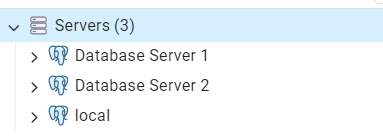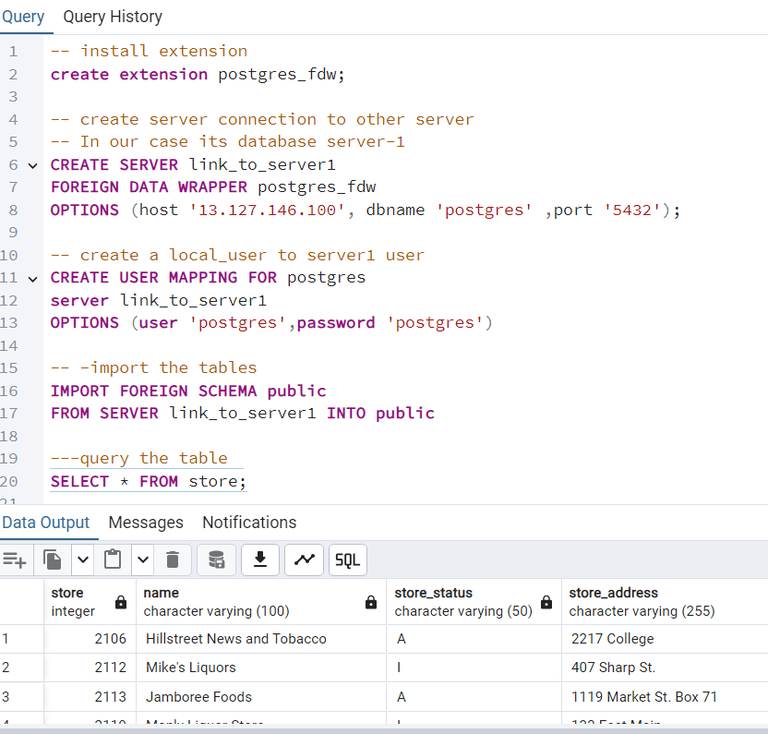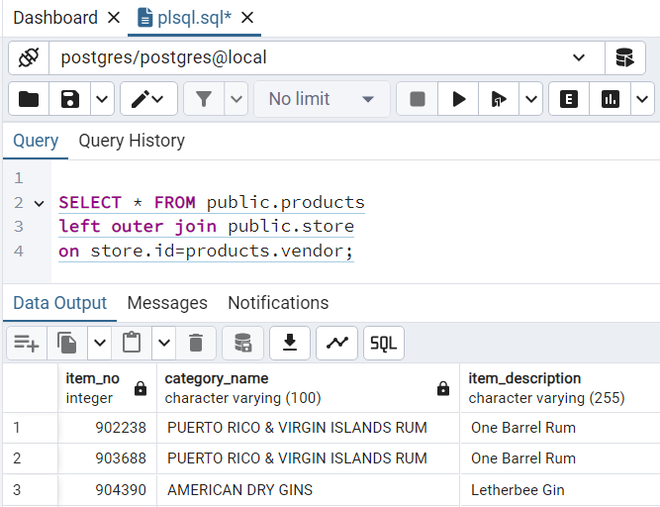
|
|
PostgreSQL is an open-source, object-relational database management system that stores data in rows, with columns representing different attributes. It enables secure data storage, processing, and retrieval. Developed by a global team of volunteers, PostgreSQL is a sophisticated database solution that is free to download and compatible with Linux, Windows, and macOS operating systems. Accessing Data from Multiple TablesAccessing data from multiple tables within the same PostgreSQL database is straightforward and can be accomplished with standard SQL JOIN operations. However, accessing data from tables in different servers’ databases requires additional steps. Let us look into some common ways we generally access data from a database. 1. Tables Present In Same DatabaseAccessing tables within the same database is simple, involving standard SQL queries with JOIN operations. SELECT * 2. Tables In Different Databases but on the Same Server(machine)When tables are in different databases on the same server, you can use the ‘dblink‘ extension to perform cross-database queries. SELECT * 3. Tables in Different Databases and also on Different Servers.Accessing data from tables on different servers requires using Foreign Data Wrappers (FDWs), which we will discuss in detail in this article. Hosting PostgreSQL on Two Different ServersFirst, we need a basic setup to work on this topic. We need PostgreSQL to be installed on three different servers and perform actions on the databases present in them through our local machine. The diagram below illustrates the layout of our PostgreSQL setup on a local machine and two AWS EC2 instances, we will use this for querying data across different databases located on separate servers from local hosts.  PostgreSQL hosted on different Servers I have installed PostgreSQL on three different machines(servers), one on my local machine and other two in AWS EC2 instances. If you are trying to setup a similar environment that I have made, ensure that you make the following changes to Postgres config files and EC2 servers security groups I have mentioned below. 1. Modify the security groupWe should change the security group to allow traffic on port 22 (SSH) and port 5432 (PostgreSQL) for the EC2 instances hosted on AWS. This step allows any externals connections to listen the Port range 5432 on which PostgreSQL runs.  Modify security groups for PostgreSQL port 2. Modify PostgreSQL config filesBy default, PostgreSQL listens only to the localhost commands, so to allow external connections to make changes to the databases we need to make the following changes to PostgreSQL config files.
sudo nano /etc/postgresql/12/main/postgresql.conf
Change listen_addresses to ‘*’.
sudo nano /etc/postgresql/12/main/pg_hba.conf
Add: host all all 0.0.0.0/0 md5
Creating Tables in All Three ServersIn this setup, we have PostgreSQL databases hosted on a local machine and two AWS EC2 instances. The goal is to access and integrate data from three tables stored across these different servers. We need some data on the databases to perform actions so I have uploaded three different datasets on three different servers.
 Sales table in local server
 Store table in server1
 Products table in server2 To get clear picture of which servers hold which tables you see the below image how I uploaded the data across different servers. we will be querying the store table in server-1 and products table in server-2 from our local host machine.  Data distribution in different servers Add Servers to pgAdmin4Note: This step is not mandatory , it just gives more clear picture on different servers which have different databases and tables.
Once You have done all the setup add both the EC2 instance servers to pgAdmin4 through the register server option available in the pdAdmin4.  Server connection into pgAdmin4 Integrating Data from Multiple PostgreSQL ServersIn this setup, we have PostgreSQL databases hosted on a local machine and two AWS EC2 instances. The goal is to access and integrate data from three tables stored across these different servers. Steps to Integrate Data To access and integrate data from tables stored on different servers, we’ll use the `postgres_fdw` (Foreign Data Wrapper) extension. This allows us to create a connection to a remote PostgreSQL database and access its tables as if they were local. 1. Install the FDW ExtensionThe `postgres_fdw` extension is installed to enable foreign data wrapper functionality, which allows PostgreSQL to access tables on a remote server. CREATE EXTENSION postgres_fdw;
2. Create a Server ConnectionNext, create a foreign server connection to the first EC2 instance (Server 1) where the `store` table is located, here we have created a new server link called “link_to_server1” (you can give any name you want), along with it I have provided my Ip address and database name on which store table resides. CREATE SERVER link_to_server1 3. Create a User MappingA user mapping is established, allowing the local PostgreSQL user (`postgres`) to authenticate with the remote server using the specified username and password. CREATE USER MAPPING FOR postgres 4. Import the TablesThe `IMPORT FOREIGN SCHEMA` command imports the schema from the remote server, making the remote tables available in the local database’s `public` schema. public schema is the default schema in all postgres servers. IMPORT FOREIGN SCHEMA public 5. Query the Remote TableOnce the foreign schema is imported, you can run SQL queries on the remote table (`store`) as if it were a local table. SELECT * FROM public.store;
Tryout in pgAdmin4Let us try all the steps in one place in pdAdmin4 playground, First, let me try querying the store table which is present in EC2 server-1 from my local machine to show that I do not have “store” table in my local machine.  No store table present in Local Host Let me show you the overall steps in one place to get clearer picture  Querying store table from Local Host Now create another server link similar to the above one to get the products table from the EC2 Instance server-2 into our local host server  Querying products table from EC2 server-2 Now we have three tables in total on our local host server, we have two foreign tables from two different servers. See the below Screenshot.  Tables in local host after all steps Operations On the TablesNow let us perform a join operation between sales and store tables and observe the results.  Join between sales and store tables Now let us perform join operation between the store table and products table, we should remember that these two tables are present in two different servers and we are retrieving data from third server i.e. local host server.  Join between store and products from local host server By using foreign data wrappers, we can efficiently manage and operate on distributed tables across different servers. This setup also enables you to perform JOIN operations between tables located on different servers as shown above. ConclusionThus, Using the postgres_fdw extension in PostgreSQL allows seamless access to data stored across different servers, making remote tables appear as local ones. This setup, demonstrated with PostgreSQL databases on a local machine and two AWS EC2 instances, simplifies data integration and querying. By leveraging foreign data wrappers, you can efficiently manage and operate on distributed data, enhancing your database’s flexibility and functionality. |
Reffered: https://www.geeksforgeeks.org
| Databases |
Type: | Geek |
Category: | Coding |
Sub Category: | Tutorial |
Uploaded by: | Admin |
Views: | 19 |